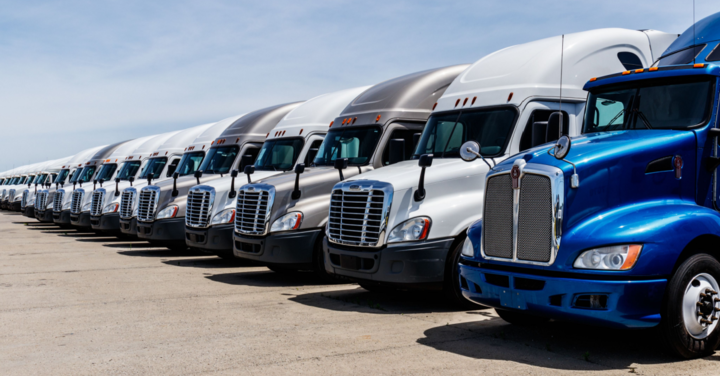When a person pictures a trucker, they probably imagine someone spending weeks on the road, hauling a trailer, and living out of their truck while traversing thousands of miles of open road.
And yes, there’s plenty of that. It’s called long haul trucking, and it’s the backbone of the U.S. economy.
But did you know that there are other types of truck transportation that are just as critical to the supply chain? One is linehaul trucking, which involves carriers that run lanes , delivering goods between two defined points.
Linehaul trucking fulfills a different function than long haul does. It runs on a predetermined, orchestrated network, in concert with LTL services. Companies depend on linehaul service everyday to make sure products get delivered on-time to their customers.
In this article, we’ll tell you everything you wanted to know about what linehaul transportation is and how it works. Buckle your seatbelt!
What Is Linehaul Shipping?
Linehaul shipping refers to the movement of freight, between two points, over a fixed route. Loads are consolidated and shipped to a distribution facility, before getting sorted and sent on to a receiver, which could be a port, warehouse, store, or railroad terminal.
Linehaul routes have defined arrival and departure times, but they could be any distance. Carriers have either interstate or intrastate authority, meaning they can cross state lines or must stay within state lines. Drivers might move loads between two cities, or from one port, warehouse, or other facility to another. The goods moved via linehaul transportation can vary as well, from small items like parcels to things like heavy machinery.
Linehaul shipping can be utilized by any mode. There are linehaul carriers employed in air, sea, and land transportation. In this article, we’ll focus on the trucking side of this transportation method.
How Do You Calculate Linehaul Rates?
Figuring out how much it will cost to move your freight boils down to a few factors. The total price for linehaul capacity is always determined by the cost per mile for a given shipment, also known as a linehaul rate. It looks roughly like this:
Total Cost = Mileage x Per Mile Rate
At the risk of oversimplifying, linehaul trucking rates reflect what a carrier is willing to accept from a shipper or a broker to move a load. This determination is often based on a number of factors, including the equipment type, the total weight and commodity of the load, the total loaded miles, fuel price, the availability of capacity, current freight market conditions, weather conditions, and delivery expectations. All of these factors contribute to the decision carriers make when they name their rate on a load.,
What Is a Linehaul Network?
When new orders are generated, it’s the job of carriers and less-than-truckload (LTL) providers to collect those items at a designated pickup center These carriers sort and consolidate freight by destination, before sending it to a distribution center.
Once a shipment arrives at a distribution center, it is further sorted and consolidated, along with other orders coming in from other pickup centers. Goods are then sent on to their final destination. The process might sound complicated, but it’s what enables large volumes of freight to move efficiently, and save both time and resources.
As you might imagine, a large infrastructure of facilities, equipment, and people are needed to keep supply chains moving. Taken together, this is what’s known as a linehaul network. It includes truck drivers and dockworkers, dispatchers and logistics coordinators, and many other workers at the shippers, sorting centers, and distribution facilities.
What Areas Does a Linehaul Carrier Impact?
- Duration of Delivery – A linehaul carrier determines how long delivery will take, and will look for ways to move freight more quickly and efficiently.
- Cost of Transportation – Carriers set freight rates based on market conditions and the particulars of a given load. Often, they track costs and work with shippers to lower them.
- Freight Movement – In the logistics world, shippers hand off freight to their linehaul carrier, and the carrier handles everything from there. That includes route, shipping speed, and time of delivery.
- Shipping To and From Depots – As we discussed above, linehaul carriers move freight headed for the same destination to a depot, like a distribution center.
- Shipping To and From Sorting Facilities – Here, goods are sorted and assembled before a linehaul carrier takes them to their final destination.
What is a Linehaul Carrier?
A linehaul carrier can be any transportation company that moves freight through a linehaul network. This includes a parcel courier, an airline, a steamship line, or a railroad company. But again, for our purposes, we’ll focus on truck carriers.
There are two important factors to consider when hiring a linehaul carrier. First, 100% service level agreement (SLA) compliance is crucial. Shippers want to work with a carrier that has a high OTIF score, and provides customers with a high satisfaction rate. Second, an optimal linehaul carrier offers flexibility to their customers, which includes FTL, and LTL service, and the ability to provide quality reefer, flatbed, and dry van capacity.
How to Become a Linehaul Carrier
Let’s say you want to get behind the wheel. Linehaul drivers operate tractor-trailers along the same routes, and with the same stops each day. Moving freight between two locations (say, from one warehouse to another) and helping to load or unload freight are two of the drivers’ primary responsibilities.
Prospective drivers will need to attend driving school, earn a commercial drivers license (CDL), and drive with an experienced CDL holder for a set period of time. There may be other company- or state-specific mandates. Occasionally, linehaul drivers are required to obtain a HAZMAT endorsement. A big perk of linehaul driving is the schedule. Unlike long haul operators, linehaul drivers have regular hours and often get to go home at the end of their work day.
Is There a Difference Between Middle-Mile, Linehaul, and Long Haul?
Middle mile, linehaul, and long haul are three different concepts that can overlap. We’ll sort them out below.
Middle mile: This involves transporting freight between two facilities. Think of moving raw materials to a factory or transporting produce from a warehouse to a distributor.
Linehaul: Involves moving freight from one location to another, along one set route. This could be from a port to a warehouse, or from one warehouse or distribution facility to another.
Long haul: Usually involves interstate carriers who drive hundreds or thousands of miles. Drivers require a sleeper cab as they may spend days or weeks on the road.
But wait, couldn’t the middle mile include both linehaul and long haul trucking? And couldn’t linehaul trucking also have a route that spans hundreds of miles? The answer to both of those questions is yes. Sometimes, the middle mile can last many hundreds of miles, making it a job for a long haul trucker.
Other times, a linehaul route could be a shipments’ middle mile. The main difference is that, while middle mile and long haul won’t always run on the same route or schedule, linehaul transportation will.
What is the Importance of Linehaul Tracking?
Living in 2022, you’ve likely heard at least a few colleagues talk about real time visibility. API platforms and other digital tools are helping shippers and carriers gain up-to-the-minute tracking on their load.
These technologies can help shipping managers find out exactly where their load is and if and when a truck has stopped or started moving. Tracking also provides insight into whether a truck has checked in to the receiver, or whether the truck will make its delivery on time.
What Is Linehaul Optimization?
By now, you’ve seen how many players are involved in a linehaul network. The workers, equipment, and delivery schedule needed to operate in concert could resemble a Rube Goldberg machine. One that spans across a state or two. With all of those moving parts, it’s crucial to keep a tight schedule. And that’s not even accounting for disruptions like traffic accidents or inclement weather.
This is where linehaul optimization enters the picture. Optimization uses a combination of strategy and technologies to keep shipping lanes as efficient as possible. There are a few keys to linehaul optimization. Carriers need to collect data on volume fluctuations, transit times, and disruptive events. Using historical data and analytical tools, they can assess the efficiency of their routes and adjust as necessary.
Why Is Linehaul Optimization Important?
Carriers have an important job. Every day, they are responsible for millions of dollars worth of freight. Truck drivers are under pressure to move goods on time to delivery and without delays or incurring damages to product. On top of that, linehaul drivers must cover huge distances each week which can place additional strains on their shoulders.
When you’re handling tens of thousands of dollars worth of goods over long distances, time becomes a critical factor. Finding optimal shipping lanes ensures that resources are used efficiently, and that scheduling needs can be met. It reduces driver hours, keeps fuel costs down, and keeps shipments arriving on time.
Here are a few tips to optimize a linehaul network:
- Keep detailed records – This should include things like scale tickets and lumper fees, time of arrival and delivery, driver information and proof of delivery.
- Reward drivers – Incentivize them to perform by paying them well and recognizing and respecting their work.
- Keep customers informed – Communication is key. If a disruption arises, it’s best to inform customers early, when there’s still time to work around it.
- Identify optimal routes – This might seem obvious, but it’s critical to avoid wasting time with routes that add extra time or distance.
- Use the right technology – Tracking platforms, GPS, ELDs and other tools can all track shipping details and store historical data.
- Partner with a dedicated third party logistics provider – Monitoring a route, managing data, calculating optimizations, and notifying customers probably sounds like a lot of work. Luckily, third party logistics providers exist to take all of those tasks off your plate.
Advantages of Linehaul Tracking
- Better SLA management – Linehaul tracking lets you see how well providers adhere to those service level agreements, so you don’t end up with poor compliance.
- Delivery productivity – By tracking, you can optimize your supply chain. And by optimizing, you can give drivers shorter, more efficient routes, and improve delivery times.
- Safer Deliveries – It’s not fun to think about, but shippers and carriers need to guard against theft, route deviations, or accidents.
- Optimize delivery operations – Your end customer wants to be prepared to receive their delivery. Tracking is how you alert them of delivery windows. It’s a win-win – customers don’t have to wait, and carriers don’t waste time at a stop.
- Fewer accidents or errors – In linehaul trucking, freight gets moved between different trucks and facilities. With tracking, you find out about problems or accidents when they happen.
- Better communication between carriers and providers – Tracking makes it possible for the carrier to provide better, more accurate information to the shipper.
- Reduced costs – Linehaul tracking can prevent excessive idling and other activities that waste fuel, slow down delivery, or both.
There’s still much chaos to iron out in the supply chain today. As DAT notes, rates have dropped since last year, but remain $0.26/mile higher than at this time pre-pandemic. A lack of available parts is pushing the equipment cycle out to new lengths. A driver shortage continues to loom.
Under these circumstances, shippers must ensure they have the infrastructure in place to move their goods to where they need to be, on time and undamaged. That’s not easy to do when drivers, equipment, and even storage space are in short supply.
An alternative to managing transportation in-house is to work with a dedicated service who has owned assets and a brokerage division. The right logistics partner will assist with carrier capacity procurement and claims management, handle disruptive shipping incidences, and keep rates from spiraling out of control – all services that AMX provides.
Shippers that are looking for an experienced transportation service provider to streamline their linehaul and long haul needs can count on AMX Logistics. AMX is a 3PL that specializes in U.S. domestic and cross-border freight into Canada, offering dependable service and coverage to ensure on-time deliveries. AMX Logistics has you covered for your linehaul needs. Give AMX Logistics a call to learn more about our dedicated logistics services today.


